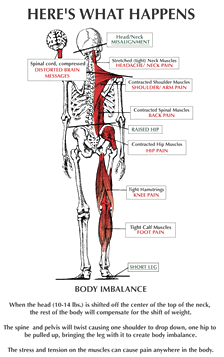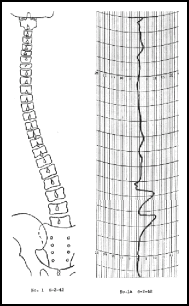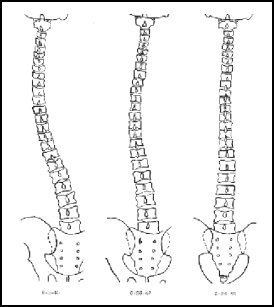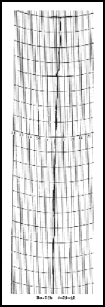Volume 2, No. 1 – February 2004
 A
Patient’s Perspective – Greg Buchanan
A
Patient’s Perspective – Greg Buchanan
I trust everyone had a great holiday and new year. This is my second newsletter
since launching my website and I plan to send eleven (11) per year, with January
being my rest month. With the kids off from school through December and January
it makes it a little hard to keep up the work!
I have had some great feedback regarding my website and newsletters and continue to get emails from people all over the world. It seems there are a lot of sufferers out there who have tried everything but haven’t yet experienced upper cervical chiropractic.
Many patients have had great responses from their first experience with upper cervical chiropractic; therefore I would encourage them and their chiropractors to consider placing their testimonials on my site via this link http://www.upcspine.com/subtest1.asp, via the link on my home page or under the menu listing ‘contact us’. The more people who have benefited from upper cervical chiropractic who provide their stories the sooner it will be realized just how powerful this approach is. Other people around the world must be told about this now!
The biggest issue for patients appears to be finding an upper cervical practitioner within a close proximity. I know that in Australia, we have only a handful of practising specialist upper cervical chiropractors. It would be nice some day to have all chiropractors trained in precision upper cervical. Any US upper cervical chiropractors want to immigrate!
In this issue I have provided some research information on the condition known as fibromyalgia. It would seem that it is becoming quite common for people, especially women to be diagnosed with this condition.
I hope you enjoy my newsletters and as always feel free to provide me with any feedback and suggestions to info@upcspine.com. They will evolve with time and with your input. I did get some feedback on my last newsletter that some of it was quite technical. Sorry, I’ve been researching this for so long that I have tended to use medical terminology, because when searching the internet and other resources it is necessary to be familiar with such terminology. I will try to and tone it down a little for the patients reading my newsletters whilst still keeping it at a level practitioners would be comfortable with.
Remember I am a patient and not a medical practitioner. My newsletters are provided as an informational source only, and are not a medical opinion. Therefore you should do further research for yourself.
Condition Report

 What
is FMS according to medical science? FMS is a chronic (i.e. long standing)
condition. The patient has muscular pain and tenderness throughout the
body and frequently other symptoms like sleep disturbances, fatigue,
hearing disturbances, muscle twitches, cold extremities, headaches & migraines,
TMJ syndrome and blurred vision. For a diagnosis of fibromyalgia to
be concluded, although fibromyalgia can be over diagnosed ,
the patient must exhibit tenderness in a minimum of 11 of 18 pre-defined
points on the body (see figures). Have a good look at the location of
these points, as I think that along with other evidence they provide
a pointer to a possible cause of FMS.
What
is FMS according to medical science? FMS is a chronic (i.e. long standing)
condition. The patient has muscular pain and tenderness throughout the
body and frequently other symptoms like sleep disturbances, fatigue,
hearing disturbances, muscle twitches, cold extremities, headaches & migraines,
TMJ syndrome and blurred vision. For a diagnosis of fibromyalgia to
be concluded, although fibromyalgia can be over diagnosed ,
the patient must exhibit tenderness in a minimum of 11 of 18 pre-defined
points on the body (see figures). Have a good look at the location of
these points, as I think that along with other evidence they provide
a pointer to a possible cause of FMS.
Although the exact cause of FMS has apparently not been discovered and there are various research theories including poor nutrition, stress factors, alterations in the pattern of sleep and changes in neuroendocrine transmitters (serotonin, substance P, growth hormone and cortisol) a common theme which appears to emerge throughout the research is that of poor posture, cervical spine dysfunction and degeneration in the spinal joints.
Hiemeyer et al[2] for example, examined 40 patients with FMS and noted the relationship between posture and tender points. They discuss disappearance of tenderness at a number of the tender point sites following correction of posture and conclude; “flexed posture could be an important factor in generalized muscular pain, and posture therefore should be an essential part of the clinical examination of patients with FMS.” Muller et al[3] state “In fibromyalgia as well as in low back pain we frequently find disturbances of the posture of vertebral column clinically and radiologically.” Further Buskila et al[4] examined two groups of patients, a control group (59) consisting of patients with leg fractures and a study group (102) with a neck injuries. “FMS was diagnosed in 21.6% of people with neck injuries versus 1.7% of those in the control group” and further “FMS was 13 times more frequent following a neck injury than following a lower extremity injury” and “almost all symptoms were more common and severe in the group with the neck injury”. Schnur[5] conducted a review of the record of 61 patients with primary fibromaylgia syndrome (PFS) and found “in over 50% of examined patients diagnostic details referred to chronic lumbar and cervical spine syndromes” and chronic lumbar and cervical spine syndromes pre-dispose the person to development of PFS. A study by Ambrogio et al[6] is interesting if only for the finding that “from a patient’s perspective, neck support is an important part of a comprehensive physiotherapy program.” Thus FMS patients, in a small study, indicate that to have some support for their necks was important to them. This is another pointer, I assert, to the cervical spine being heavily involved in the origin of FMS. In fact, I believe, like others before me, that it is highly likely that a subluxation at the level of the atlas is the causal factor in the generation of FMS, and patients should be checked by professional precision upper cervical chiropractors. Such subluxations not only initiate pain in the neck, head, and shoulders, but also have been shown to directly cause postural distortions.[7] A study by Larsson R, Oberg PA, Larsson SE[8] is interesting because the authors propose “chronic neck pain may increase the transmitter activity of neuropeptides in the upper cervical medulla causing impairment of blood flow in the local muscle” and conclude “an impaired regulation of the microcirculation in the local muscle is of central importance in chronic trapezius myalgia, causing nioceptive pain.” This study, these two studies[9,10], and many other studies by Larsson et al, show patients with neck and shoulder pain as having reduced blood flow through these painful muscles, further exacerbating the pain. I assert that if your “head is not on straight”, your cervical and shoulder muscles fight to maintain your head erect. These spasms I believe cause the neck, back and shoulder pain associated with FMS. Further atrophy (wasting) of these muscles due most probably to reduced blood flow just compounds the painful problem. |
 Could
it be that an upper cervical subluxation uncorrected over a long period
directly causes FMS? Let’s look at Dr Daniel Clark’s (www.uppercervicalillustrations.com)
graphic opposite. (Reprinted with permission from Daniel O. Clark, D.C.)
Could
it be that an upper cervical subluxation uncorrected over a long period
directly causes FMS? Let’s look at Dr Daniel Clark’s (www.uppercervicalillustrations.com)
graphic opposite. (Reprinted with permission from Daniel O. Clark, D.C.)
This is what is known in upper cervical chiropractic circles to occur to the
body/skeleton when one sustains an atlas subluxation. Now look at the location
of the tender points in the previous diagrams. I contend that if you overlay
those tender points over this diagram, the tender points will correlate highly
to muscle tension caused by the misaligned skeleton. The neck, shoulder, pelvis
and knees are all affected by the upper cervical subluxation. The 10 tender
points to the top of the body (front and rear) could be caused by the muscles
straining to hold the head perpendicular. The others may be due to the unlevel
pelvis and corresponding functional short leg. Now think about the earlier
references to poor posture and cervical spine disorders in those people with
FMS. Is there a connection? I think so.
Not many therapies appear to be successful at alleviating FMS symptoms. One study by Freidman and Nelson does discuss some success with some individuals using “ice water circulating through hollow metal tubes” which was delivered “intraorally for 15 minutes in the posterior maxillary area”. According to the authors, 9 out of 12 patients had “reduced cervical pain perception” and electromyography revealed less upper trapezius signal, or lessening of pain in the trapezius muscles. The authors suggest a “strong trigemino-cervical relationship to neck pain and headache.” There’s that reference to neck (cervical) pain again!
If an upper cervical subluxation is responsible for postural changes, neck pain and the development of FMS as I suggest then upper cervical chiropractic may have a role to play in the treatment of FMS patients.
Like conventional treatment studies however, there haven’t been a lot of studies which demonstrate the efficacy of a chiropractic treatment for FMS, but if you read the chiropractic studies the results appear to be quite favourable.
A
study by Blunt, Rajwani and Guerriero[12] of
21 patients consisted of a utilizing “chiropractic spinal
manipulation, soft tissue therapy and passive stretching” and
the results indicated that “chiropractic
management improved patients’ cervical and lumbar ranges
of motion .. and reported pain levels” and
a study by Hains[13] combining spinal
manipulation and ischemic compression resulted in a “statistically
significant lessening of pain intensity and corresponding improvement
in quality of sleep and fatigue level.” Hains and Hains
conclude that the “study suggests
a potential role for chiropractic care in the management of
fibromyalgia”.
|
In a study of 23 patients with fibromyalgia by Amalu he states “The most common medical treatments for FMS and CFS can include one or more of the following: tricyclic antidepressants, nonsteroidal anti-inflammatories, physical therapy, gentle stretching, low impact exercises, stress reduction, counseling, and lidocaine injections with or without hydrocortisone”. It is not uncommon for FMS or CFS patients themselves to try many treatments including but not limited to physical therapy, massage, acupuncture, mainstream chiropractic, osteopathy, medications and exercise with little to no improvement. As a result of pursuit of these multiple therapies it is also a common for patients to doubt the efficacy of yet another treatment like upper cervical chiropractic.
However, you will note that Amalu’s “treatment consisted
solely of corrections to aberrant arthrokinematic function of the occipito-atlanto-axial
complex.” In other words treatment to correct dysfunction of the
upper cervical spine [C0(skull)-C1(atlas)-C2(axis)]. He uses an upper
cervical chiropractic method of adjusting known as Applied Upper Cervical
Biomechanics (International Upper Cervical Chiropractic Association-IUCCA)
in combination with paraspinal infrared scans to measure the stabilization
of the upper cervical joint complex and hence effectiveness of the adjustment.
See my site http://www.upcspine.com/tech12.htm for
a description of this upper cervical approach and for Dr Amalu’s paper
see my research section.
Amalu found “Upon stabilizing the upper cervical spine .. improvement in the symptomatic profile of both FMS and CFS was 92-100% (VAS) for all 23 patients. Chronic fatigue syndrome (CFS) is mentioned because invariably FMS patients are also diagnosed with CFS. Read the entire case for the patient outcomes.
In
conclusion Amalu states “The
body of literature detailing the upper cervical spine’s
role in affecting global physiology is substantial. Further
research into this area of the spine, combined with objective
monitoring of neurophysiology, may reveal that chiropractic
does indeed offer a consistent conservative solution for patients
with fibromyalgia and chronic fatigue syndrome.”
|
Chiropractic Testimonials
Some further reading in the form of testimonials can be found at the following sites. In my testimonial section are some fibromyalgia testimonials from patients of the Brooks Spinal Care clinic http://www.brooksspinalcare.com/. Dr Brooks is the current President of the National Upper Cervical Chiropractic Association (NUCCA), www.nucca.org. Dr Brooks and his staff are achieving amazing results with the treatment of FMS and CFS patients.
Dr Erin Elster www.erinelster.com is
also achieving wonderful results with a range of conditions. See her
fibromyalgia and chronic fatigue testimonial section
http://www.erinelster.com/Case%20Studies/fibromyalgia_case_studies.html for
some great success stories.
Read
also this testimonial from Sonya Porter of the Fibromaylgia
Support Group after following upper cervical chiropractic treatment. “Upper
cervical chiropractic care should be considered one of the possible
treatment paths available for the improvement of fibromyalgia
symptoms as well as improved general health.” |
The Chiropractic Green Books
 For
this month I have selected an interesting case from the Green Books
which demonstrates correction of a scoliotic curve by manipulation of
the upper cervical spine in a patient suffering from low back pain and
sciactic trouble. In this Case #1131 B.J.
Palmer uses spinographs (X-rays) and the neurocalograph (NC), an instrument
for the measure of nerve interference, to manage the patient.
For
this month I have selected an interesting case from the Green Books
which demonstrates correction of a scoliotic curve by manipulation of
the upper cervical spine in a patient suffering from low back pain and
sciactic trouble. In this Case #1131 B.J.
Palmer uses spinographs (X-rays) and the neurocalograph (NC), an instrument
for the measure of nerve interference, to manage the patient.
The re-drawing of the X-ray and NC output are shown in this diagram opposite. The NC shows nerve interference to be in the lower back, which corresponds with the patient’s pain. Further the upper cervical NC shows nerve interference in the upper cervical region. Palmer focussed on the upper cervical spine as the area of adjustment. Specific cervical pictures revealed axis (C2) subluxated posterior and right.
Throughout this case Palmer gathers feedback from the patient and with the spinographs and NC is able to show marked improvement in both scoliotic curve and nerve interference.
The glow feelings are common amongst patients I have been involved with. Both my wife and I experienced a warm feeling down to our feet immediately following our very first upper cervical adjustment. Following are some of the chronological events described by the patient and Palmer during the treatment process. The point of this is that changes to the body, especially one which has been racked with pain for years takes time. However, the body is a wonderful piece of engineering and if in the right state can keep itself well maintained.
 The
patient continued to improve with Palmer using the NC to monitor changes
in both the upper cervical spine and lower spine. The final spinographs
(right diagram) reveal improved scoliotic curve and the final NC (above)
reveals complete reduction in signal and nerve interference. Remember
the only chiropractic adjustment being done by Palmer was the upper
cervical adjustment to axis (C2). Please note that X-rays of FMS patients
do usually reveal scoliosis. Upper cervical subluxations can and do
cause scoliosis. Toftness www.toftness.org has
one of the largest collections of pre and post scoliosis correction
X-rays available today. I refer you to the book “Chiropractic
Spinal Correction”, I.N. Toftness, D.C. and the following web
page:-
The
patient continued to improve with Palmer using the NC to monitor changes
in both the upper cervical spine and lower spine. The final spinographs
(right diagram) reveal improved scoliotic curve and the final NC (above)
reveals complete reduction in signal and nerve interference. Remember
the only chiropractic adjustment being done by Palmer was the upper
cervical adjustment to axis (C2). Please note that X-rays of FMS patients
do usually reveal scoliosis. Upper cervical subluxations can and do
cause scoliosis. Toftness www.toftness.org has
one of the largest collections of pre and post scoliosis correction
X-rays available today. I refer you to the book “Chiropractic
Spinal Correction”, I.N. Toftness, D.C. and the following web
page:-
http://www.airstreamcomm.net/~toftness/Book.htm.
Also I refer you to Appendix D of Kirk Eriksen’s recently published
book “Upper Cervical Subluxation
Complex: A Review of the Chiropractic and Medical Literature” for
some excellent pre and post adjustment X-rays of scoliosis.
Further Reading – related to Newsletter Research Topic
Upcspine.com Updates and Additions
I have quite a few website updates coming over the next few months, including a page on the Zimmerman Adjusting Machine, Toftness technique and a page on the CBP technique.
The latest update however, is an additional page at which I hope to provide links to upper cervical chiropractic testimonial pages, see ‘testimonials’ under the ‘evidence’ menu or click here http://www.upcspine.com/tmlinks.asp. I have also added further papers to my research section. The only thing holding me back here is the time to read and summarize them all before placing them up on my site. I have literally hundreds of references to be added.
If any patients or chiropractors have information in regards to good research references or testimonial websites, please let me know. Contact me at info@upcspine.com.
These newsletters will also be posted on my site in the new future
at URL
http://www.upcspine.com/newsletters.asp.
Upcspine.com Shop
 |
My upcspine.com shop is provided for the purchase of various merchandise and collateral. The proceeds will be used as follows:
|
I have available for purchase various T-shirts, caps, pens, notepads, mouse pads, patient brochures & cards and Xmas cards. All prices are quoted in Australian dollars.
Disclaimer
References
|
home | site map| privacy | disclaimers | credits

 Neurocalograph
Reading: Pattern very rough in middle cervicals. Please note no return
of reading at base of skull. Patient Report: “Leg and knee gaining
strength; no tendency to cave in on stairs. Itchy sensation in leg deep
as though healing was in progress. Resting better all the time. Vitality
picking up. Walked too far on crutches last night which gave little
stiffness in leg this morning.”
Neurocalograph
Reading: Pattern very rough in middle cervicals. Please note no return
of reading at base of skull. Patient Report: “Leg and knee gaining
strength; no tendency to cave in on stairs. Itchy sensation in leg deep
as though healing was in progress. Resting better all the time. Vitality
picking up. Walked too far on crutches last night which gave little
stiffness in leg this morning.”